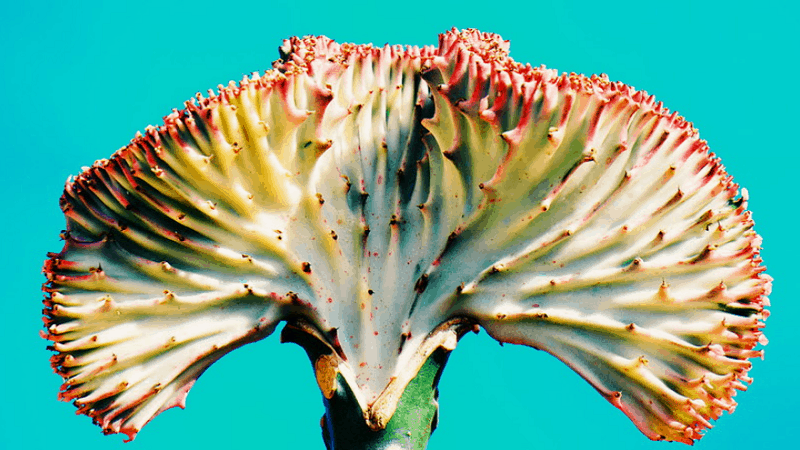The genus Euphorbia is included in the family of Euphorbiaceae and is made up of more than 2,000 species of cactiform plants (cactus-like), herbaceous plants and shrubs or trees.
It is known by the vulgar names of cristata, Crested Euphorbia, Crested Plant or Crested Candlestick Plant.
It is a native species of India and Sri Lanka.
They are cactiform euphorbias of curious crested and wavy green stems with yellowish, pink or violet spots. They have no leaves but have black spines on parts of their waving ribs. They do not usually bloom.
These plants of very slow growth and easy cultivation are often used in pots as indoor or terrace plants.
If the weather permits, they are suitable for rockery and cactus and succulent gardens.
It is a bright, very branched, 3-sided, succulent and markedly ringed plant with very white and green ornamental marble marbling.
All parts of the Euphorbia Milky are considered poisonous, especially the milky sap.
It is a tall, dark green, very branched and spiny bush, with a distinctive silhouette that grows to more than 3-6 m tall (or more), but rarely does it in cultivation.
Stems, erect, approximately 5 cm in diameter, constrained in oblong green segments.
Center of the segments visibly pale often with ornamental white and lime green marbled.
Ribs: 3 (or 4) slightly winged, sinuous
Leaves, has only the smallest indication of leaves at the tips of growth in summer.
The leaves are rudimentary, circular, reddish, up to 3 mm in diameter, deciduous,
Thorns: tiny but sharp, paired, very divergent along the margins and are usually 2 to 6 mm long.
Tips to take care of the Euphorbia lactea “Cristata”
This plant is not resistant to temperatures below 5ºC and most can grow in pots (excellent potted plant) or the plant in very protected places.
The Euphorbia lactea “Cristata”, is of a tropical climate, is one of the few columnar Euphorbias that grow exceptionally well in very humid climates.
It can be kept in full sun or in semi-shade, but because of its motley shape, it is better to be protected from the strong sun in the hottest hours of the day.
It is a suitable substrate for this plant is a mixture formed by equal parts of clay and sand.
Euphorbia lactea “Cristata” in greenhouses, apparently rarely, are affected by fungal diseases.
It responds well to warmth, with its period of active growth in the last months of spring and summer.
For fertilization, diluted liquid fertilizer can be used in the irrigation water every 15 days or using organic fertilizer, the amount depends on the format.
These operations should be performed in the months of growth of the Euphorbia Milky (spring and summer) and in a less strong dose in autumn.
How to water
For irrigation, the substrate must be dry and must be watered about three times a week, during active growth, in summer.
In Winter it is better not to water them practically nothing, that is, they should be suspended or restricted only once during the winter.
The most common failure in the growth of the Euphorbia lactea “Cristata” is irrigation, especially during the winter months.
It likes porous soil with adequate drainage.
How to reproduce the Euphorbia
It is propagated by cuttings or stakes, while marbled and crested forms are difficult to grow on their roots, and are usually grafted for convenience in Euphorbia Canariensis or Resiniferous Euphorbia.
It is recommended to take Euphorbia cuttings in spring / summer, when the plant is growing so that they have a better chance of success.
The key is heat and good air circulation.
These cuts should be dipped in powdered hormones, although it is not essential.
Keep them there for a period of 3-4 weeks, before planting it.
Next, plant in a pot and do not water abundantly (keep slightly moist) until the cutting is well established.
These will take root very well, if we place the pot outside during the summer.
Next, we attach an explanatory video on how to outline the Milky Euphorbia, all have a similar method.
It is in English, you can activate subtitles or stay with the essentials of the process.
Warning.
As with all other varieties of Euphorbias, when a plant is damaged, a thick white milky sap emanates.
This sap is conceived as latex.
This latex is poisonous and particularly dangerous for eyes, skin and mucous membranes.
It is extremely irritating to the tissues of the mucosa and capable of causing temporary blindness if it touches the eyes.
Beware of children at home and take precautions when handling this species. Therefore, pay close attention not to be affected in the eyes or mouth.
Cultivated plants should be handled very carefully.
